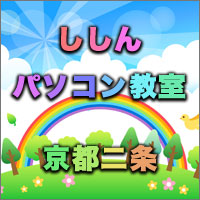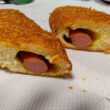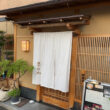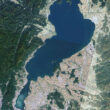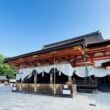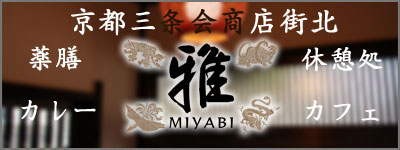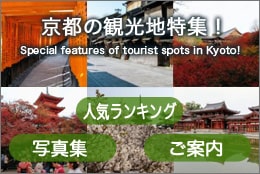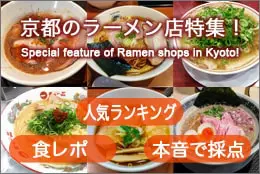A Visit to Kimchi no Hoshiyama, a Korean Food Specialty Store in Saiin
Posted date:2025-09-19Author:つばくろ(Tsubakuro) Transrator:ポンタ(Ponta)
Category:Kyoto Gourmet , Talk about Kyoto
広告
adsense4
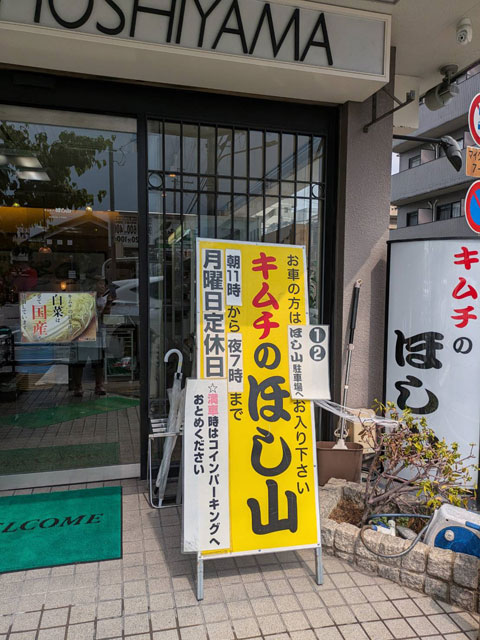
Kimuchi no Hoshiyama shop entrance
To begin with
What makes our kimuchi special? Well, I suppose it’s how it evolved from the Korean-style flavor emphasizing mature fermentation under the first generation to the current second generation’s mellow taste using kombu dashi, tailored for Japanese palates. I kept wondering if this flavor would please people, or what about that one, and after all that trial and error, we ended up with seven different flavors just for the napa cabbage kimuchi. What makes our chijimi special? Well, it’s all about the flavor from the start-seasoned with dashi made from kombu and bonito flakes.
When I requested an interview for this visit, Mr. Yanagihara, manager of the Saiin branch of “Kimuchi no Hoshiyama,” readily agreed. His first words were:
“How about them? Take a look at these kimuchi. Their flavors are just right, I tell you.”
As I listened to the story and looked around, I could see it was true – everywhere I looked was bright red. If you look at the photos, you’ll see I’m not exaggerating at all.
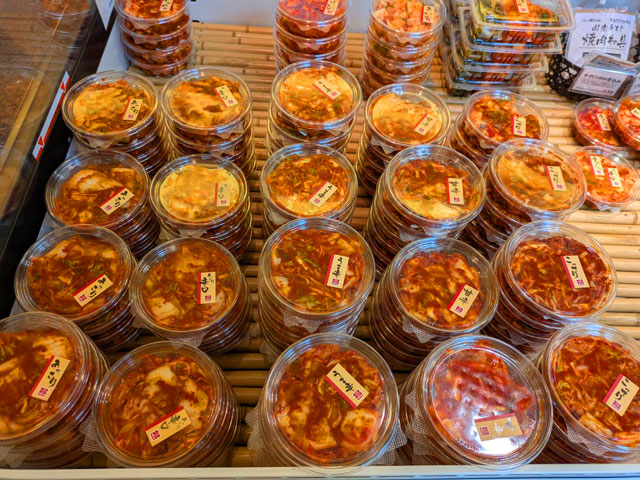
Packed kimuchi
The bright red kimuchi that makes me sigh is all napa cabbage kimuchi.
As Mr. Yanagihara says, the sheer variety of flavors is immediately apparent just by looking at the selection.
Light, rich, sweet-spicy, savory-spicy, spicy…
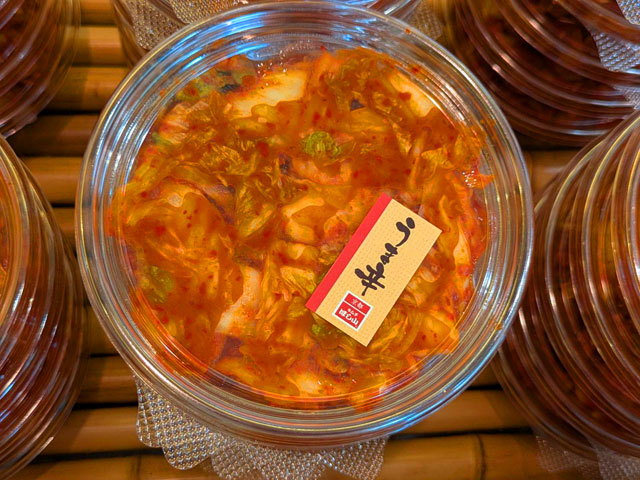
Individually packed napa cabbage kimuchi
On this day, Columnist visited “Kimuchi no Hoshiyama,” a specialty store for Korean ingredients located in Saiin, Uyo Ward.
Now let me introduce the shop’s overview, incorporating conversations with the manager, Mr. Yanagihara, along with my personal taste experiences.
Comparing the taste of chijimi from Turuhashi’s Koreatown and Korean Market with those made by “Kimuchi no Hoshiyama”
The area stretching from Ikuno Ward to Higashinari Ward in Osaka City, known as Koreatown, has long been renowned for having the highest concentration of ethnic Koreans in Japan, both historically and today.
Among them, Ikuno Ward has become a major tourist attraction in Osaka, drawing a constant stream of visitors thanks to the popularity of Korean dramas and the influence of Korean stars.
The JR Loop Line connects directly to Ikuno and Higashinari Wards.
Furthermore, Turuhashi Station stands out as the largest station among those closest to Ikuno and Higashinari Wards.
Well, beneath the elevated tracks at Turihashi Station lies a vast market.
On the surface, it’s a wholesale market dealing in fresh fish for professional vendors. But as you venture deeper into it, the atmosphere suddenly shifts, and out of nowhere, a Korean market appears.
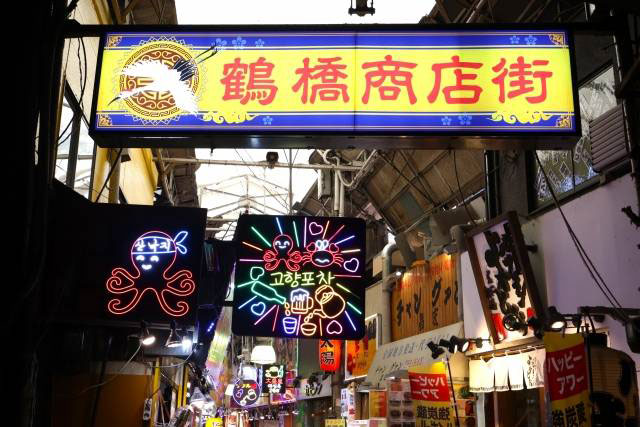
Entrance to Turuhashi Korean Market
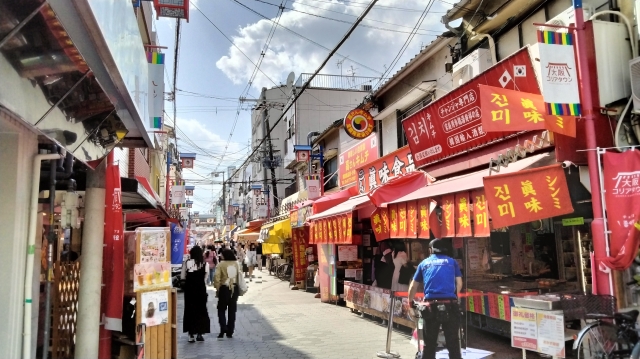
The central aisle of Turuhashi Korean Market
The first time I, Columnist visited here was when I accompanied my best friend’s family, who lived in Osaka, on their year-end shopping trip.
To the eye of this Kyoto native columnist, everything seemed novel and fresh, but for those raised in Osaka, visiting the Korean market at year’s end seemed perfectly natural.
While wandering through the vast Korean market, my best friend pointed and said, “There’s chijimi. This is delicious, why don’t you buy some?” That was my first encounter with authentic chijimi.
The chijimi I bought back then looked pretty much like this.
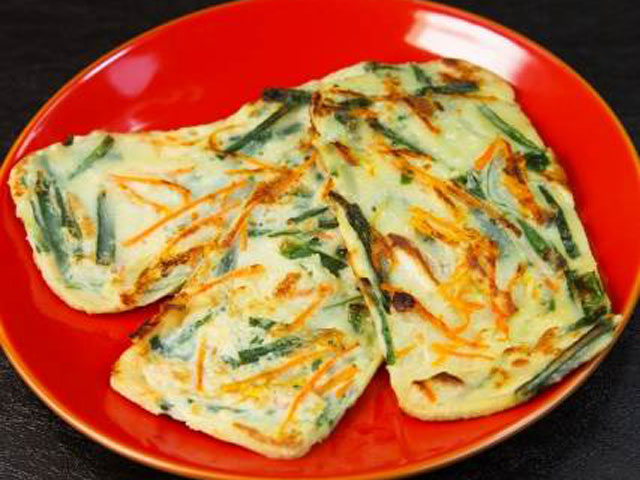
Korean Market chijimi
After returning home, Columnist took a bite and was captivated by its light yet rich flavor. From then on, I frequently made trips to the Korean market in Turuhashi, Osaka, to buy chijimi.
The price of a single chijimi at the time I frequented most often was 450 yen.
Korean market chijimi is sold at street stalls, with a huge number of vendors offering it. The taste varies from stall to stall, but the price seems to be fixed by a price agreement, so it’s the same no matter where you buy it.
Well, I suppose I’ve gone on a bit about the Korean market, but one day when I was telling an acquaintance about the chijimi in Turuhashi, that person mentioned the existence of “Kimuchi no Hoshiyama.”
No need to trek all the way to Osaka – you can find authentic chijimi right here in Saiin.
So, I jumped at the chance and bought these.
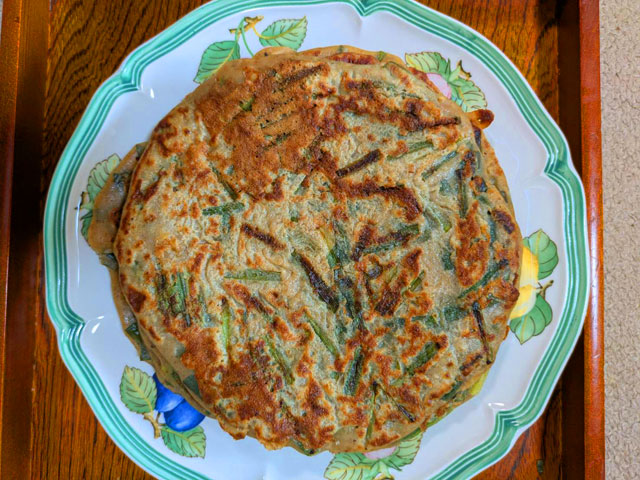
Chijimi served on the plate
I, columnist still remember the surprise I felt the first time I tasted the chijimi from “Kimuchi no Hoshiyama.”
Compare the photos of the chijimi from Turuhashi introduced earlier with the chijimi from “Kimuchi no Hoshiyama.”

鶴橋のチヂミの写真

Photo of chijimi from Turuhashi
The color is completely different.
Hoshiyama’s chijimi has a brown batter throughout.
This is because Kimuchi no Hoshiyama’s chijimi is made by kneading the batter with an original Japanese-style broth based on kombu and bonito.
Turuhashi’s chijimi is not made using any such methods, so the color when cooked reflects the natural color of the flour itself – a creamy yellow.
As mentioned earlier, the taste is completely different.
Hoshiyama’s chijimi is seasoned with kombu and bonito dashi, and contains Korean chili peppers, making it rich and spicy.
When you buy it, they tell you, “It’s already well seasoned, so just eat it as is.”
However, even though it features a Japanese-style dashi broth, it is by no means the light, Kyoto-style flavor.
It’s a bold, spicy, and rich flavor – the complete opposite of a gentle taste.
The chili peppers pack a punch, so tears start streaming down your face as you keep eating.
The variations of Hoshiyama’s chijimi include four types: garlic chive chijimi, seafood chijimi, beef tendon chijimi, and Kujo green onion chijimi.
The sight of freshly baked chijimi lined up in rows inside the shop is truly impressive, no matter how many times you see it.
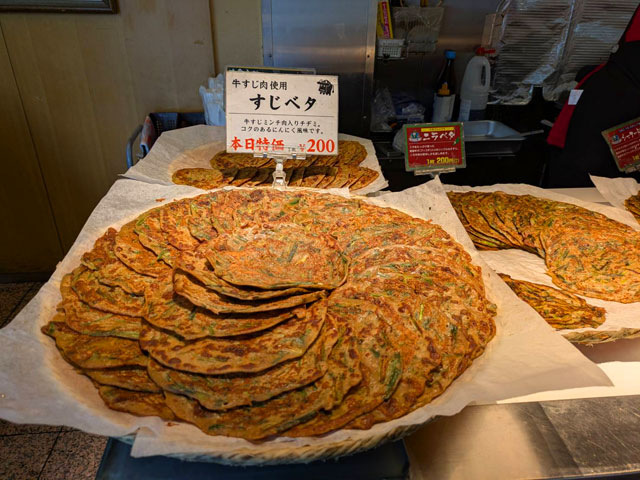
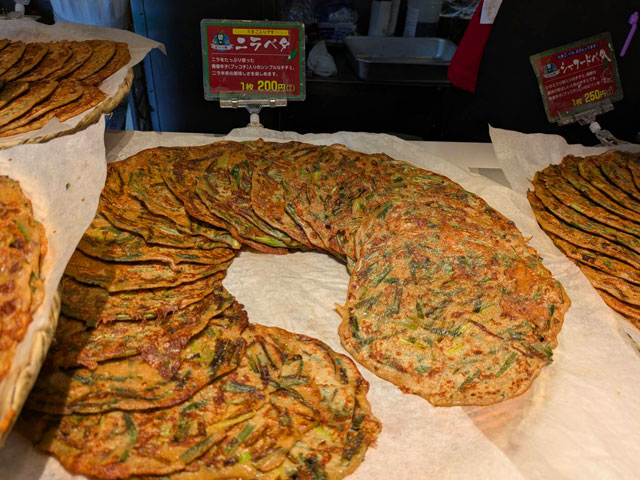
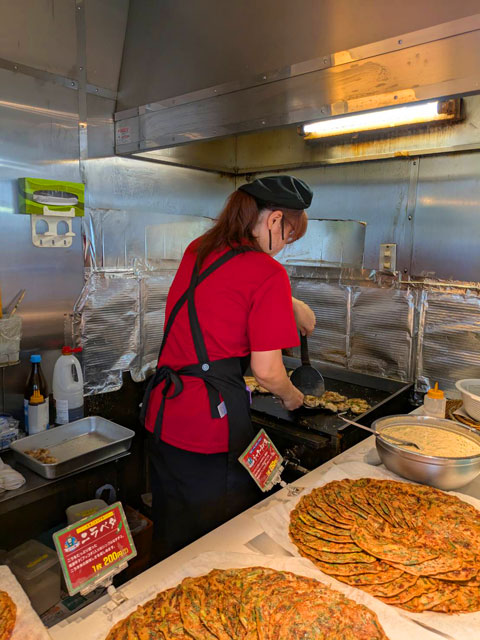
By the way, the prices for Hoshiyama’s chijimi are: Garlic chive chijimi: 200-yen, Seafood chijimi: 250-yen, Beef tendon chijimi: 250 yen, Kujo green onion chijimi: 150 yen.
This has remained unchanged for ten years since the columnist began visiting this shop.
It’s less than half the price in Turuhashi, so you could say it’s very reasonably priced.
However, it’s also true that I’m surprised every time I visit the shop.
“Oh, it’s gotten smaller again!”
After thoroughly comparing various types of chijimi, the columnist’s conclusion is roughly as follows.
Hoshiyama’s chijimi is a distinctive chijimi.
The texture and bite feel are quite springy, leaning toward a squishy, chewy quality.
Both the texture and the seasoning itself might be a matter of personal preference.
At first, I was a bit confused by how things worked differently, but I’ve gradually gotten used to it. Lastly, I’ve even started thinking, “This is pretty tasty, huh?”
The introduction of the shop and products of “Kimuchi no Hoshiyama”
Having covered the details of the chijimi, I will now discuss the various kimuchi offerings and other products where this shop truly shines.
Store Manager Mr. Yanagihara explained the history of “Kimuchi no Hoshiyama” and the taste of its kimuchi.
“Our shop was originally founded in Mibu, and later relocated to Umezu where we established our current store. It was 1958. The first president was Renjun Hoshiyama, who came over from Korea, and she was the mother (Omoni) of the current second-generation president. To support her difficult life in unfamiliar Japan, our founding mother made kimuchi and sold it door-to-door. The origin of our flavor lies in that rich, savory napa cabbage kimuchi she peddled.”
It seems they’ve been adjusting the flavors to suit Japanese tastes, and now offer seven different varieties of cabbage kimuchi alone.
It is also known for producing kimuchi made with vegetables other than napa cabbage.
For example, there’s diced daikon radish kimuchi, cucumber kimuchi, komatuna kimuchi, chive kimuchi, and water kimuchi.
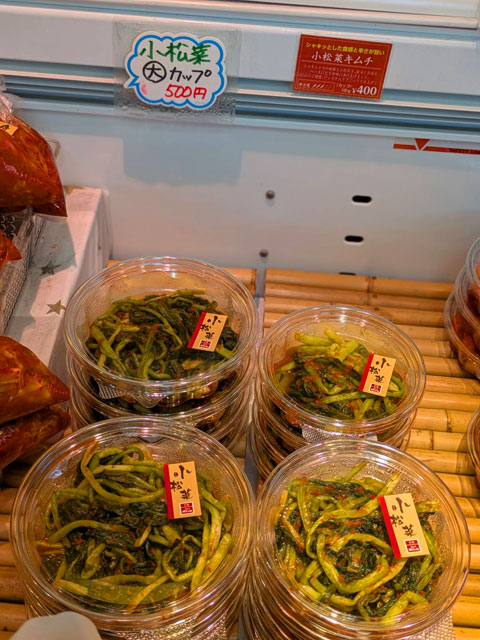
Komatuna kimuchi
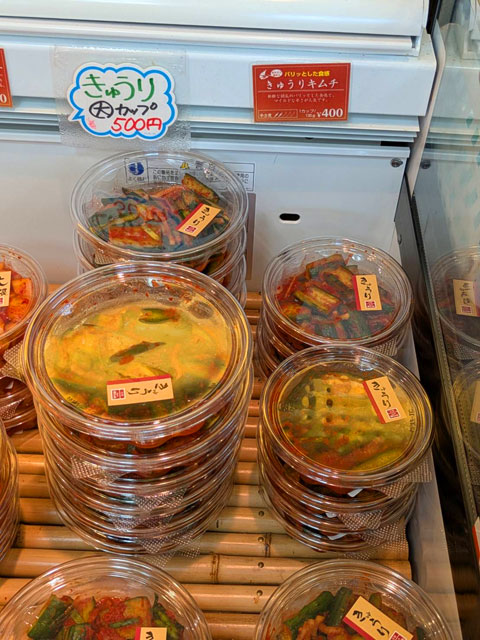
Cucumber kimuchi
I’d love to share my thoughts on the taste of kimuchi, but unfortunately, I dislike pickled foods and, on top of that, has an aversion to the spiciness of chili peppers.
For that reason, I have never once eaten kimuchi since the day I was born.
Therefore, to be honest, I can’t really whether kimuchi is good or bad.
Now, inside the shop, alongside kimuchi and chijimi, Korean ingredients and Korean dishes are lined up in abundance.
With a wide selection of classic steamed pork and assorted seasonings, anyone interested in Korea is sure to be captivated upon visiting.
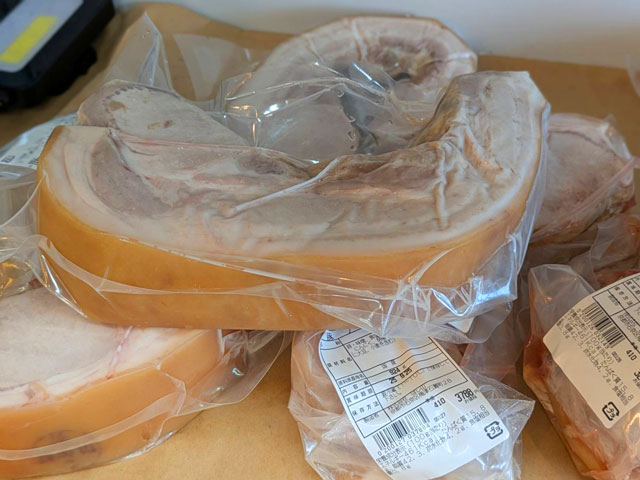
Steamed pork
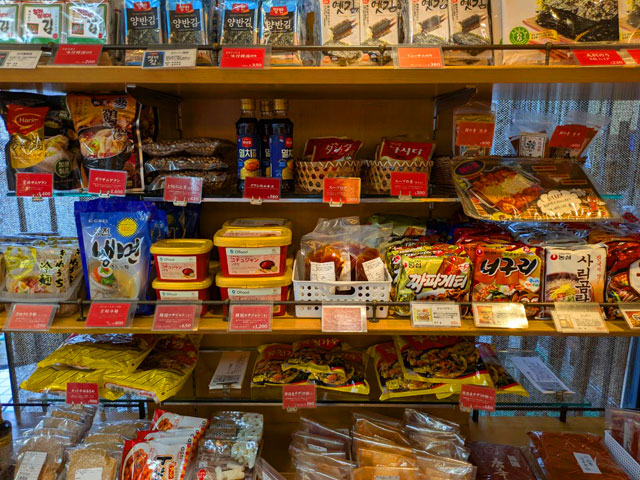
Korean seasonings
Additionally, they carry bibimbap kits and other items, allowing you to enjoy authentic Korean cuisine at home.
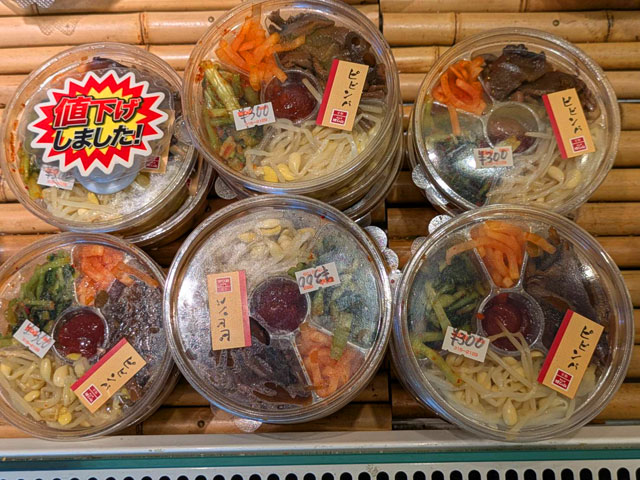
Bibimbap
In addition, ready-to-eat side dishes are also available for purchase.
The lineup also includes popular rice accompaniments like spicy grilled chicken wings and simmered mackerel.
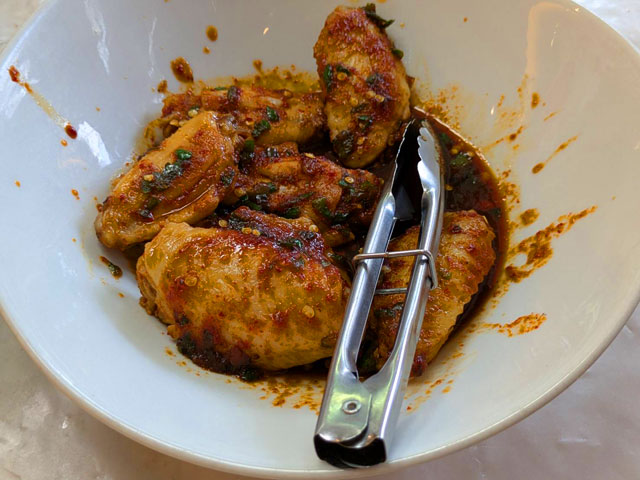
Spicy chicken wing 1
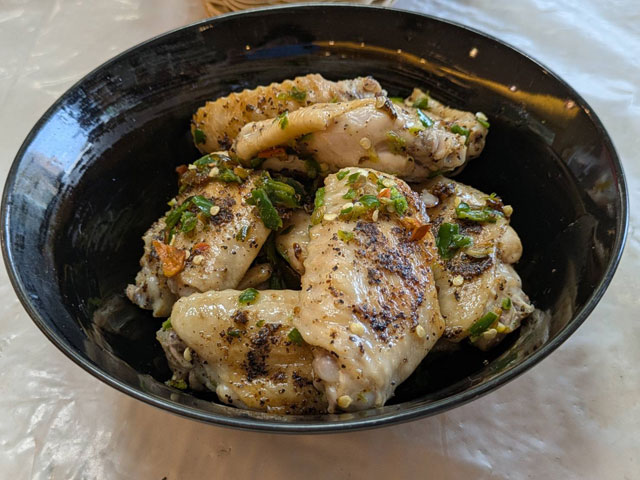
Spicy chicken wing 2
A wide selection of Korean instant noodles is also available.
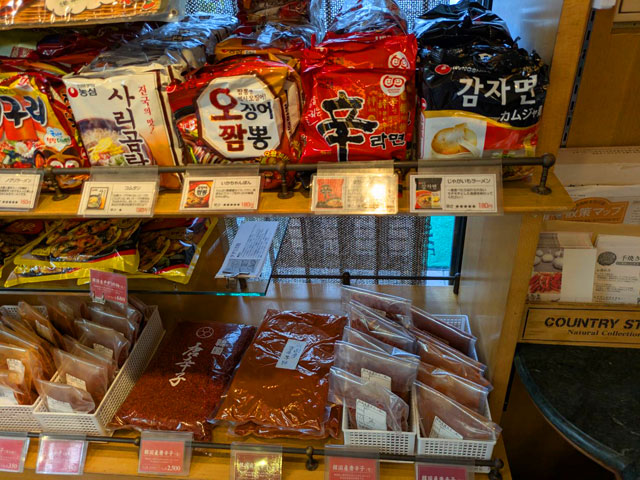
Korean instant noodles
The columnist asked, “What kind of customers frequent your shop? Do you get many overseas tourists?”
Then, Mr. Yanagihara said, “This area around Saiin doesn’t really have any major attractions, does it? That’s why tourists hardly ever come here. It’s all local customers. These days, we can’t tell whether they’re Japanese nationals or Zainichi Koreans.”
The conclusion
The areas with the largest populations of Zainichi Koreans in Kyoto City are Nishikujo and Saiin area in Ukyo Ward.
While there are several kimuchi shops in Nishikujo, Kimuchi no Hoshiyama is a place you can easily walk into even if you know nothing about Korean cuisine or ingredients.
I’ve never been to Nishikujo before, but even comparing it to the Korean market in Turuhashi I used to frequent, “Kimuchi no Hoshiyama” here stands out by far for its ease of entry.
Another major appeal is the extensive selection, which generally includes everything you could want.
Unfortunately, I, columnist, who am all about chijimi, doesn’t really have time to look at other products, but if you’re interested in Korea, please do visit at least once.
Even if you don’t feel like buying anything, I guarantee you’ll have a great time just browsing.
Store information
Kimuchi no Hoshiyama Kyoto Saiin Store
- The address: 〒615-0026 Kyoto Prefecture Kyoto City Ukyo Ward Saiin Kita-yakake town 31
- TEL: 075-315-2129
- URL: https://hoshiyama.ne.jp/
- Transportation access:
15-minute walk from Hankyu “Saiin Station”
15-minute walk from Kyoto City Bus stop “Nishioji-Shijo”
15-minute walk from Randen “Saiin Station” - The business hours: 11:00 – 19:00
- Regular holidays: Mondays
Author
つばくろ(Tsubakuro)
I was born and raised in Kyoto and am a native Kyotoite.
When I was young, I longed to visit Tokyo and Osaka, which are more bustling than Kyoto, but as I have gotten older, I have come to appreciate Kyoto a little more.
In this site, I will introduce you to some of the best places to explore Kyoto's food that you might otherwise miss at first glance.
